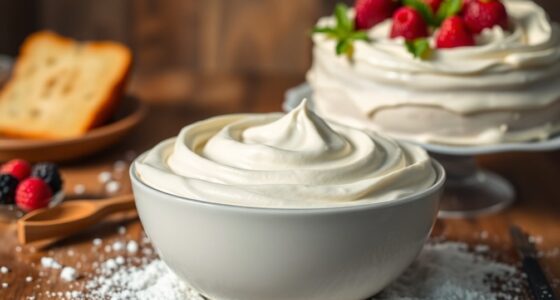You might think a pound cake is too simple to impress, but its rich flavor and dense texture can easily elevate any gathering. This classic dessert, with its roots firmly planted in history, offers a canvas for countless variations that can suit your preferences. Curious about how to balance tradition with modern twists, while ensuring that every slice remains moist and flavorful? You'll want to explore the nuances of the recipe and cooking steps that can transform this straightforward cake into a standout dessert.
Key Takeaways
- Traditional pound cake uses equal parts of butter, sugar, eggs, and flour, typically 1 pound each.
- Cream 1 ½ cups of softened unsalted butter with 3 cups of granulated sugar until light and fluffy.
- Incorporate 5 large room-temperature eggs one at a time, mixing well after each addition.
- Gradually add 3 cups of all-purpose flour until just combined to maintain a light texture.
- Bake in a preheated oven at 325°F for 1 to 1.5 hours or until a toothpick comes out clean.
History

When you think about pound cake, it's fascinating to know that its name comes from the original recipe, which called for a pound each of butter, sugar, eggs, and flour.
This traditional recipe dates back to Northern Europe in the early 1700s, where bakers created a dense texture by omitting leavening agents. As the recipe migrated to the Southern United States, adaptations emerged, introducing milk, sour cream, and flavorings that produced a moist crumb.
By the 1970s, pound cake's popularity soared, with modern twists incorporating soft drinks and various flavors while honoring cherished family recipes.
Today, it's a beloved staple of Southern cuisine, often gracing church cookbooks and family gatherings, demonstrating its enduring place in baking history.
Recipe
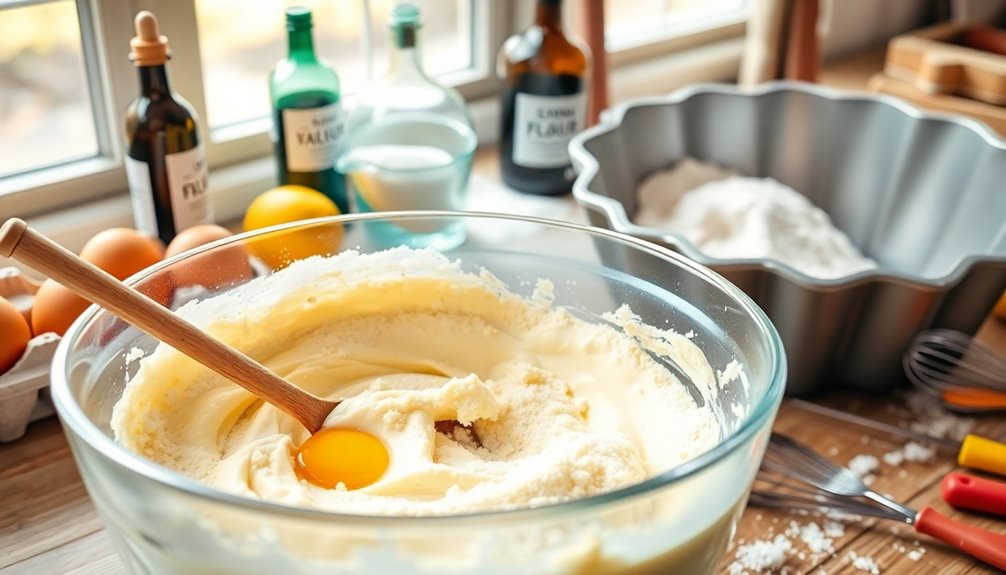
Pound cake is a beloved dessert known for its rich flavor and dense texture. This classic cake is perfect for a variety of occasions, from casual gatherings to formal celebrations. Its simplicity lies in the use of equal weights of its key ingredients: butter, sugar, eggs, and flour. This balance not only provides a satisfying taste but also ensures a moist crumb that pairs wonderfully with various toppings or can be enjoyed on its own.
The beauty of pound cake is in its versatility. You can easily customize the flavor by incorporating extracts like vanilla, almond, or lemon, or even add chocolate for a decadent twist. Whether you serve it with whipped cream and fresh fruit or enjoy it plain with a cup of tea, pound cake is sure to impress. Follow this recipe to create your own delightful pound cake that will be a hit with friends and family.
Ingredients:
- 1 ½ cups unsalted butter (softened to room temperature)
- 3 cups granulated sugar
- 5 large eggs (at room temperature)
- 3 cups all-purpose flour
- Optional: 1 tablespoon vanilla extract or lemon extract
Cooking Instructions:
Preheat your oven to 325°F. In a large mixing bowl, cream together the softened butter and granulated sugar until the mixture is light and fluffy. Gradually add the eggs one at a time, mixing well after each addition.
Slowly incorporate the flour until just combined, taking care not to overmix. Pour the batter into a greased and floured bundt or loaf pan, and bake in the preheated oven for 1 to 1.5 hours, or until a toothpick inserted in the center comes out clean. Allow the cake to cool in the pan for about 15-20 minutes before transferring it to a wire rack to cool completely.
Extra Tips:
To achieve the best results, ensure all your ingredients are at room temperature before you start mixing, as this helps create a smoother batter and a tender crumb.
Be mindful not to overmix your batter once the flour is added, as this can lead to a denser cake. If you're looking to add flavor variations, consider folding in chocolate chips or nuts for added texture.
Lastly, storing your pound cake in an airtight container at room temperature will keep it fresh for several days, making it a wonderful treat for any time of the day.
Cooking Steps
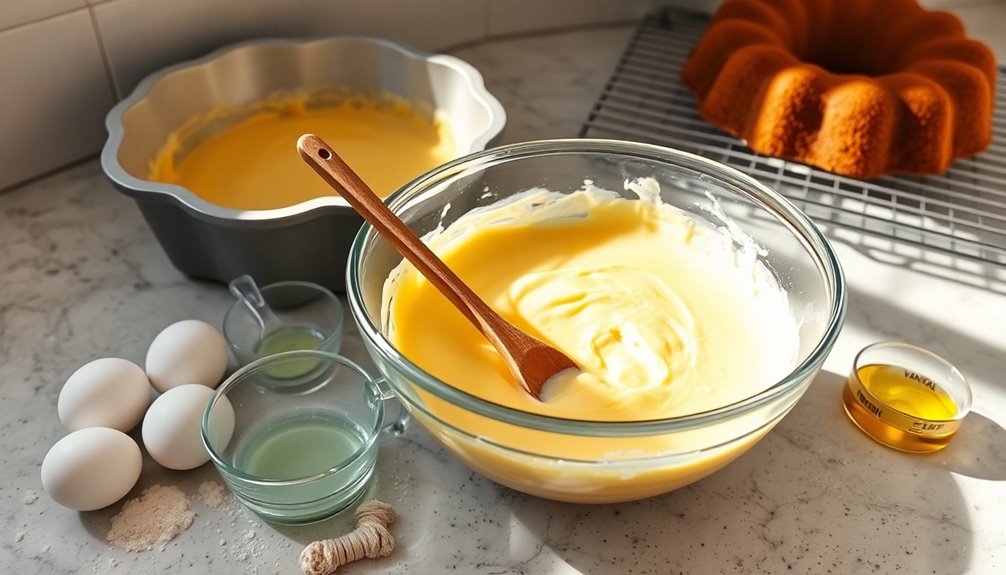
Now that you've got your ingredients ready, it's time to start cooking!
First, preheat your oven to 350°F, then mix the softened butter and sugar until it's light and fluffy.
Next, you'll add the eggs one at a time to create a rich batter before folding in the flour mixture.
Step 1. Preheat Oven to 350°F
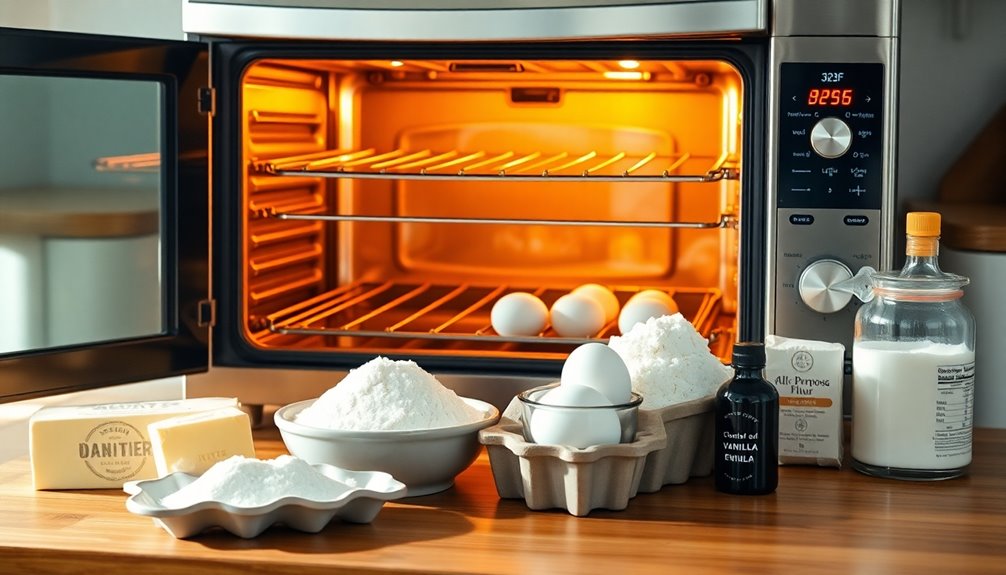
To achieve the best results for your pound cake, preheat your oven to 350°F (175°C). This temperature ensures even baking and a proper rise.
Before you start preheating, prepare your baking pan by greasing and flouring it. This step will make cake removal much easier later on.
Allow your oven to reach the desired temperature; using an oven thermometer can help verify accuracy, as some ovens can be off by several degrees.
Once the cake is in, monitor it closely during the first half of baking. Remember, opening the oven door can cause the cake to collapse, so resist the urge to peek too soon.
Your patience will pay off with a perfectly baked pound cake!
Step 2. Mix Butter and Sugar
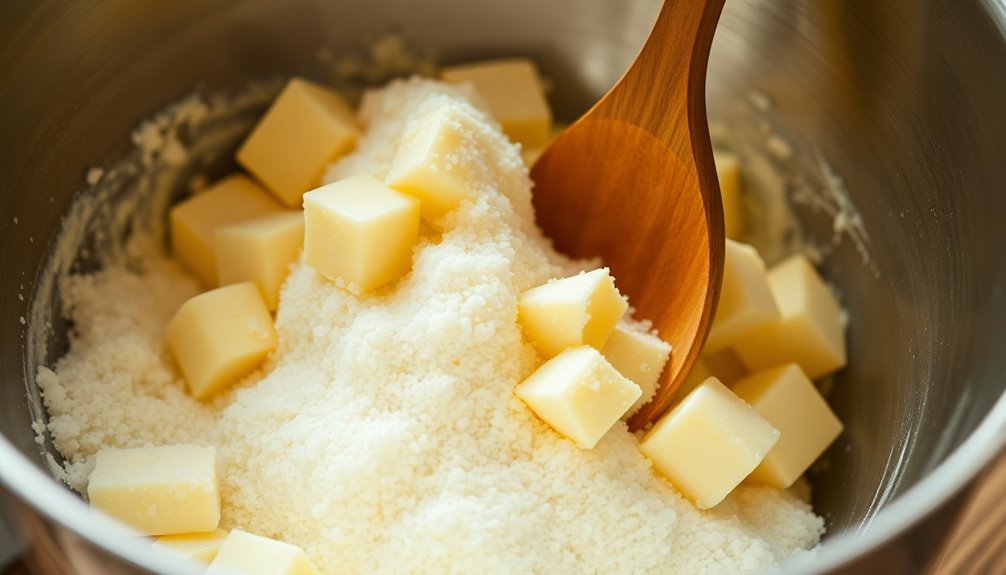
Start by ensuring your unsalted butter is at room temperature. This helps incorporate air effectively during the creaming process, giving you a lighter cake.
Using a stand mixer, cream the butter for about 3-5 minutes until it's smooth and fluffy. Gradually add the granulated sugar while mixing continuously. You'll know it's ready when the mixture becomes pale and fluffy, indicating it's well-aerated.
Remember to scrape down the sides of the mixing bowl periodically to avoid any lumps of butter or sugar. Properly creaming the butter and sugar together is crucial, as it helps incorporate air into the batter, contributing to the cake's rise and texture.
This step sets the foundation for a delicious pound cake!
Step 3. Add Eggs One at a Time

As you continue with your pound cake batter, add the eggs one at a time to ensure they incorporate smoothly.
It's essential to use room temperature eggs, as they blend easily with the creamed butter and sugar, creating a smooth and uniform mixture. After adding each egg, make sure it's fully mixed in before adding the next.
This step helps maintain a stable emulsion and prevents your batter from becoming dense or curdled. Additionally, this technique traps air in the batter, which is crucial for leavening and achieving a light and airy cake.
Step 4. Fold in the Flour Mixture
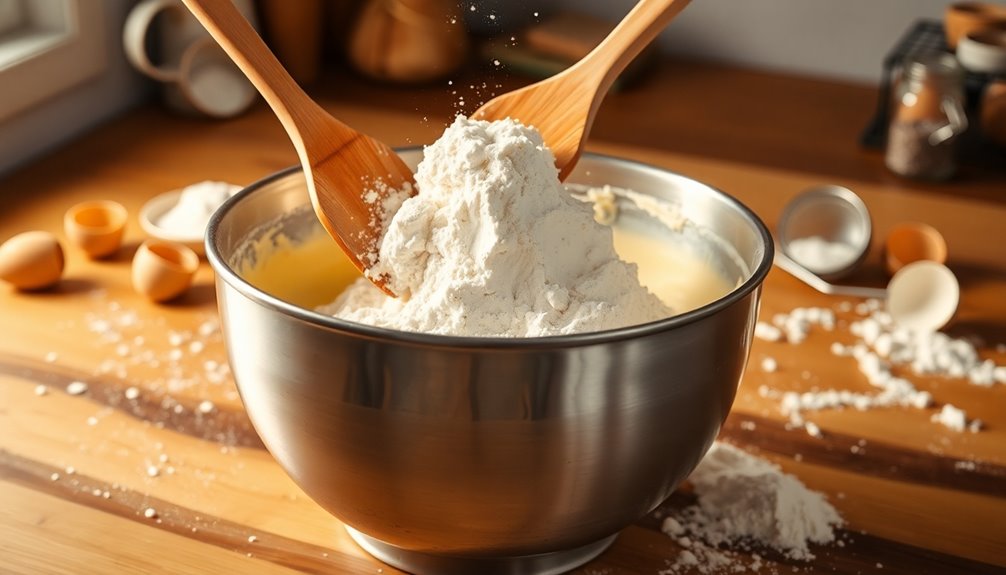
Now it's time to fold in the flour mixture. Gradually add the flour to the creamed butter, sugar, and egg mixture, being careful to prevent overmixing, which can lead to a dense cake.
Using a spatula, gently fold in the flour mixture, scraping the sides of the bowl to ensure everything is well combined. Incorporate the flour in three additions, alternating with liquid ingredients, to maintain a light and airy batter.
Stop mixing as soon as no dry flour remains visible, focusing on achieving the desired moistness in your pound cake. Remember, overworking the batter can result in a tough texture, so be gentle and precise to keep that perfect balance.
Step 5. Add Milk for Moisture
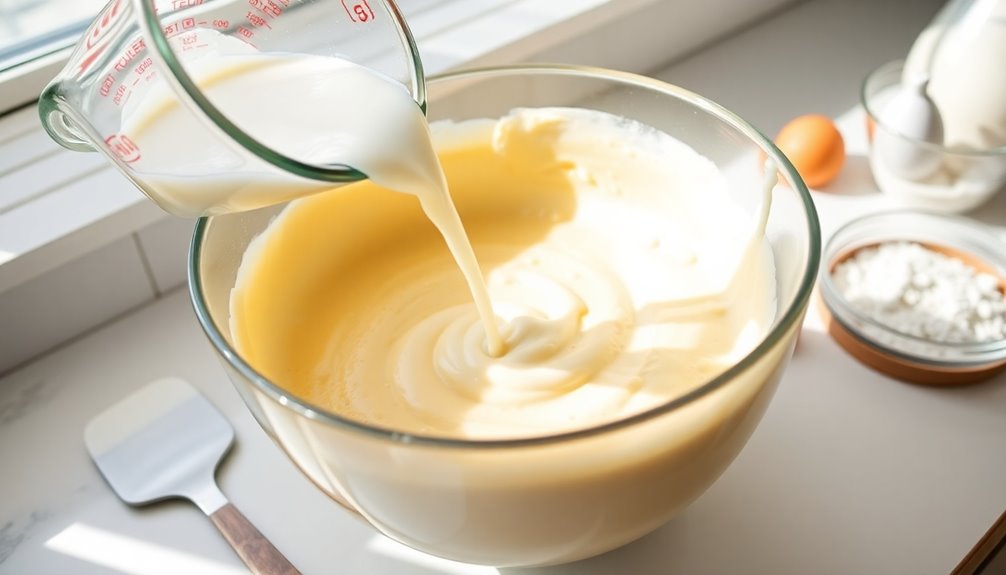
To achieve a moist and tender pound cake, you'll want to incorporate milk into your batter. Adding one cup of milk or buttermilk enhances moisture and creates a tender crumb, balancing the cake's density.
Make sure your milk is at room temperature; this ensures it blends smoothly with the other ingredients and maintains an even consistency. The richness of the milk complements the sweetness of the sugar and the buttery flavor of the cake, enriching the overall taste.
For optimal results, gradually mix the milk into the batter after adding the eggs. This careful integration allows you to achieve the classic pound cake structure without overmixing, ensuring a delightful, light, and moist dessert that everyone will love.
Final Thoughts
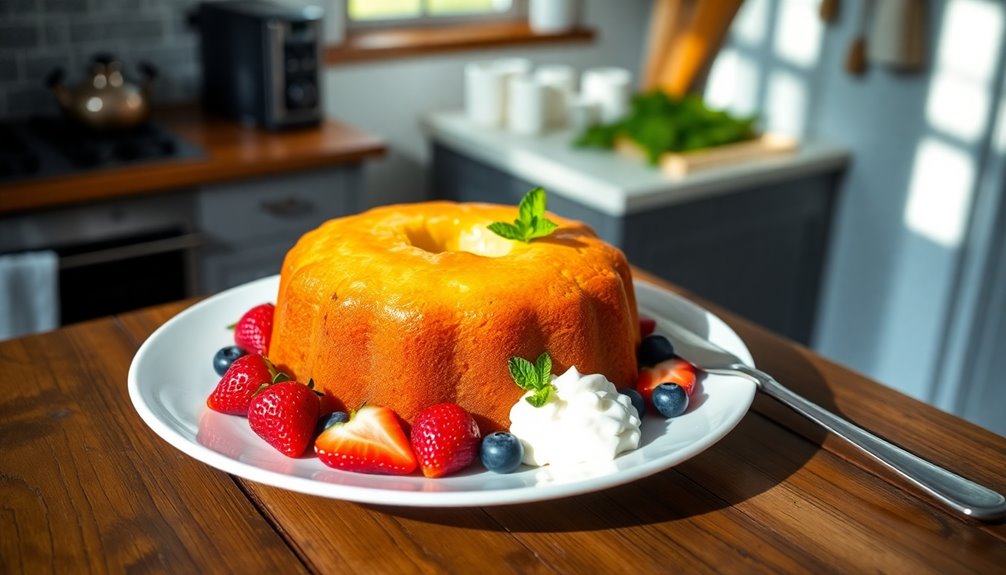
Creating a perfect pound cake is a rewarding experience that blends simplicity with flavor. To achieve the best pound cake, focus on using quality ingredients like unsalted butter, all-purpose flour, and large eggs.
Incorporating vanilla extract or lemon extract can elevate the taste, while ensuring your baking time is just right—about 60 to 75 minutes at 350°F. Remember, a moist cake is all about avoiding overbaking; use a skewer to test for doneness.
Once baked, let it cool on a cooling rack to maintain that dense texture. Store any leftovers in an airtight container to keep them fresh.
With these tips, you'll create a delicious pound cake that's perfect for any occasion! Enjoy your baking journey!





